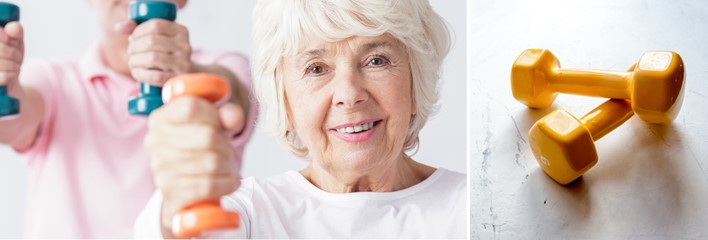Physical exercise
For people living with Parkinson's, just like everyone else, exercise has been shown to have numerous positive effects on physical and mental wellbeing. That’s why it’s important to stay active in everyday life, and to maintain your quality of life, with the right fitness programme.


How can I get started on an exercise regimen?
It depends on your overall fitness level, but you should talk to your primary care physician and have a thorough checkup before starting any activity. For most people it's important to start slowly, and not do too much too soon. A good way to start is with the guidance of a physiotherapist. They can work with you to determine what you can do safely.
Stay active with the right training
The best workout is one that you enjoy – whether it's walking, hiking, cycling, gymnastics, Pilates, yoga, swimming or dancing. Particularly in the early stages of Parkinson’s, there are no restrictions. You can maintain your current activity or try something new. Even later on, when something may be harder for you than it used to be, sports and physical exercise can still have a positive effect on different aspects of your condition and on your quality of life.
What exercise can help with:
- Gait pattern and speed
- Strength
- Balance
- Level of pain experienced
- Mood
- Everyday activities
Minimise the risk of falling
You should be careful when exercising to minimise the risk of falls, especially if you have advanced Parkinson’s.
If cycling outdoors is no longer possible, or you have not cycled for a while, a ‘stationary bike’ that you can use at home or at the gym can offer a safe alternative. It trains endurance and agility and also has the bonus that it can be used in any weather.
Exercises that are done while standing depend on your ability to balance. So you may need assistance from another person while doing these. You can reduce the risk of falling by doing lying or sitting down exercises, such as those using an exercise ball.
It's more fun together
Depending on the stage of your disease, it may be best for you to train with others so that help is available if you need it.
If you are new to an exercise programme, you may benefit from training with an instructor or group leader.
A good starting goal to aim for is 2.5 hours every week, increasing your physical activity by 30 minutes each week.
Why not ask your family or friends to join you in your activities?
No matter which exercise you choose, you should get started as soon as possible and always consult with your doctor and / or physiotherapist before you begin. This will help to make sure that you get the maximum benefit from your training.
Tips for being physically active
Here are a few tips from the National Parkinson’s Foundation to help increase your chance of success:
Step 1 – Getting started - Start your day with some gentle stretching exercises.
Step 2 – Go for a walk - Ask a friend or a relative to come with you.
Step 3 – Know your limits - Don’t try to do too much too soon. Start exercising for a few minutes each day and gradually increase your time according to your ability.
Step 4 – Keep a record - Writing down your activities on a calendar can help to motivate you.
Step 5 – Make it a habit - Incorporate exercise into your daily routine so that it becomes an automatic habit.
Step 6 – Enjoy it - Do activities that give you pleasure. Having another person do activities with you can make them more enjoyable.
And remember the rewards…
You may:
- sleep better
- reduce your stress levels
- have more energy
- be more relaxed
Send your Feedback!
Would you recommend the UCBCares website to other visitors?
